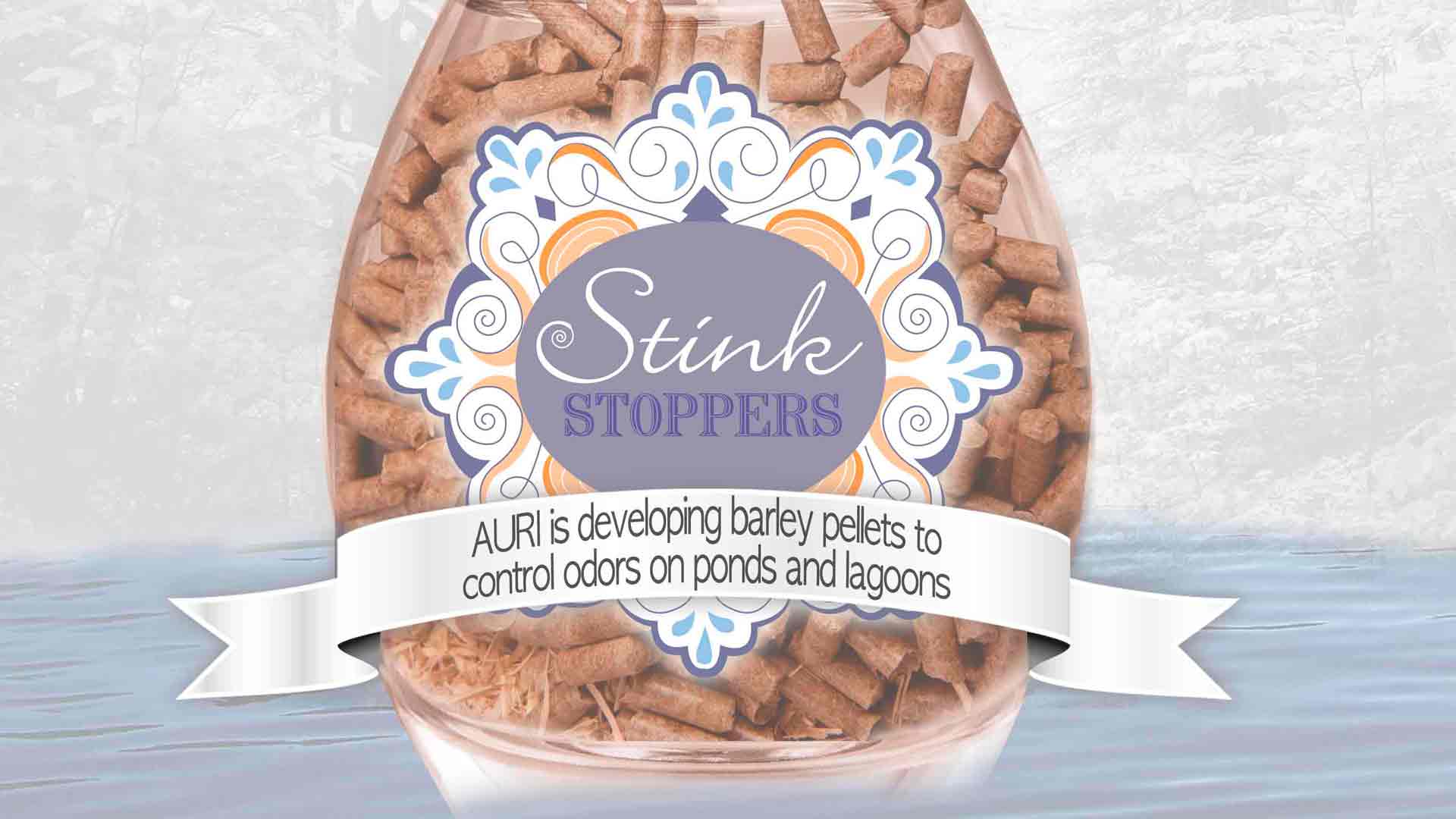Barley isn’t just for beer and breakfast anymore.
Research confirms that a natural enzyme in barley straw inhibits odor. “We’ve seen barley straw used successfully to control odor emitted from swine facilities, spread over lagoons to control odor and floated on lakes to control the spread of algae,” says Marvin Zutz, president of the Minnesota Barley Growers Association.
But transporting barley straw bales to markets on the East Coast and southern states, where demand is highest, is prohibitively expensive.
So AURI project director Becky Philipp designed an initiative to connect supply with demand. In December, AURI scientist Al Doering started densifying barley straw into pellets. Various forms will be tested to see if they float while maintaining enzymes that control odor.
Talk is cheap and productive
After articles appeared about barley’s odor and algae control benefits, Zutz says he, “started getting calls from municipalities, airports and the like,” seeking barley to spread on city ponds and between runways. “Then they find out the cost is pretty prohibitive unless they can find it closer.”
Philipp sparked the initiative to densify straw while talking to Zutz at a stakeholder meeting. “We were brainstorming how they could find new uses for barley,” Philipp says.
“Traditionally, barley has been grown in northern Minnesota” … but “over the years, barley production has declined significantly,” which is one of the barley association’s primary concerns, Philipp says.
Zutz told Philipp about barley straw’s odor and algae control properties and potential markets that couldn’t be reached because transporting bales any distance isn’t economically feasible.
“I said, ‘you’ve got to be able to do something with that to meet the demands,’ and asked if I could do a barley straw initiative using pellets,” Philipp says.
“It’s a unique idea and it’s my first big initiative,” since shifting to project director in March, says Philipp, who has served in AURI human resource positions for nearly a decade.
Odor trials
To make sure the barley initiative wasn’t duplicating other efforts, Philipp asked AURI researcher Lea Reitmeier to conduct a literature search, which she reviewed with Doering.
“There has been research where they chopped up straw and blew it over lagoons for odor control. And there is actually a patent pending on cubing straw,” Doering says. “But you can only afford to ship it so far — 100 to 150 miles.”
Nobody has tried stopping odor with dense barley pellets that are easy to ship.
“When you pellet, you can make different densities so it will swell and expand rather than sink to the bottom,” Doering says. “It should float, break apart and form a mat.”
“But we’re looking at: if you do pellet barley straw, do you change the properties or characteristics needed for
odor control?”
After Doering experiments with various pellet forms, he will test them on contained water with added household ammonia. “We’ll sprinkle ground barley straw over it and pellets over it, and we have instruments that can test how well it’s preventing ammonia release.”
Following contained-water trials, Doering will test ground and pelleted barley straw on swine manure from a hog pit to see if it contains ammonia and hydrogen sulfide, which “is what you smell from manure,” he says.
Market economics
“If we learn we can pellet (barley straw) and get it to float on water and break apart and form a mat, then we have to look at the economics,” Doering says.
“By densifying, we can ship it further, but we’ve added some expense through processing.” Is it economical? “Until we start, we don’t know.”
“We’re trying to develop a product so we can move a Minnesota commodity out to the market, and since the markets are already established, that helps,” Doering says.
If barley-straw pellets are feasible and economical, “the next step will be to tie it to marketing,” Philipp says. The Minnesota Barley Growers Association and AURI will identify a Minnesota commercialization partner to manufacture and market the pellets.
“Overall, it is the hope that by finding alternative uses for barley and more demand for it, producers will again consider if it is cost-effective to return to producing barley,” Philipp says.
A short-season crop, barley is primarily grown in the northern plains states of Minnesota, North Dakota, Montana, Idaho, Oregon and Washington. Beside animal feed and food, it is used for malting, which has become the primary use as malt barley commands a premium price.
In Minnesota, from 2008 to 2009, barley production dropped from 125,000 to 95,000 planted acres — tiny compared to 7.6 million corn acres and 7.2 million soybean acres.
“Hopefully, by condensing barley straw into a form that can be transported more economically, it will create a new market for barley coproducts,” Zutz says.
“Personally and professionally, I’m really excited about it,” Philipp says. “Having been raised on a wheat and barley farm, I hope we can develop something positive out of this, so it can add to the bottom line
for producers.”
